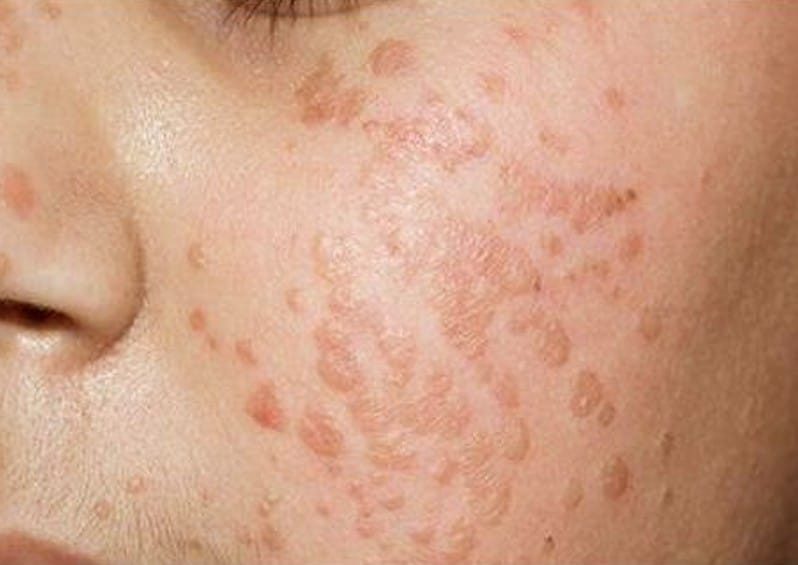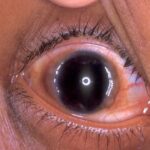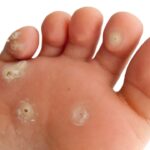Verruca plana, commonly referred to as flat warts, are benign epidermal proliferations caused by specific strains of the human papillomavirus (HPV), particularly HPV types 3, 10, 28, and 49. These lesions are most prevalent in children and young adults, often appearing in clusters on the face, neck, hands, and extremities. Unlike common warts, they are flat-topped, smooth, and often slightly pigmented, making them less conspicuous but equally distressing for affected individuals.

Etiology: What Causes Verruca Plana?
Verruca plana arises due to infection with low-risk HPV subtypes. The virus gains entry through microscopic abrasions in the skin, initiating epithelial hyperplasia and keratinocyte proliferation. Autoinoculation is common, where scratching or shaving spreads the virus to adjacent areas. Although contagious through direct skin contact, the incubation period may span weeks to months, complicating early detection.
Clinical Presentation: Identifying Flat Warts
Flat warts typically manifest as:
- Flat or slightly elevated papules with a smooth surface
- Skin-colored to brownish appearance
- Diameter of 1–5 mm
- Grouped or linear arrangements due to autoinoculation (Koebner phenomenon)
Common Sites of Occurrence:
| Location | Frequency (%) |
|---|---|
| Face | High |
| Forearms/Hands | Moderate |
| Legs (esp. in females) | Moderate |
| Beard area (in men) | Moderate |
Diagnostic Techniques: Confirming Verruca Plana
While clinical diagnosis is often sufficient, certain cases may warrant further evaluation to rule out differential diagnoses such as molluscum contagiosum, acne, or seborrheic keratosis.
Diagnostic Tools:
- Dermatoscopy: Reveals pinpoint black dots (thrombosed capillaries)
- Histopathology: Shows hyperkeratosis, acanthosis, and vacuolated keratinocytes (koilocytosis)
- PCR Testing: Confirms HPV subtype in atypical presentations
Differential Diagnosis
| Condition | Distinguishing Feature |
|---|---|
| Molluscum contagiosum | Central umbilication |
| Acne vulgaris | Presence of pustules and comedones |
| Seborrheic keratosis | Waxy, stuck-on appearance |
| Lichen planus | Violaceous hue and Wickham’s striae |
Treatment Options for Verruca Plana
1. Topical Therapies
- Retinoic acid (0.05%): Normalizes keratinization
- 5-Fluorouracil (5-FU): Antimetabolite targeting rapidly dividing cells
- Salicylic acid: Keratolytic effect
2. Cryotherapy
- Application of liquid nitrogen causes necrosis and immune stimulation
- Requires multiple sessions; may cause hypopigmentation
3. Laser Therapy
- Pulsed dye laser: Targets vasculature of warts
- CO₂ laser: Vaporizes lesions; requires local anesthesia
4. Oral and Systemic Treatments
- Cimetidine (off-label): Immunomodulatory effect
- Isotretinoin: Used for extensive, resistant cases
- Imiquimod: Topical immune response modifier
Prognosis and Management Strategy
Although verruca plana is benign and self-limiting in many cases, resolution can take months to years. Early treatment minimizes cosmetic concerns and viral spread. Recurrences are possible, especially in immunocompromised individuals.
Preventive Measures:
- Avoid sharing personal items like razors
- Use gloves in communal environments
- Maintain skin hygiene and integrity
Verruca Plana in Immunocompromised Patients
Patients with weakened immune systems (e.g., HIV-positive or post-transplant individuals) may develop extensive and recalcitrant lesions. In such populations, aggressive combination therapy is often required, and regular follow-up is essential.
Pediatric Considerations
In children, spontaneous resolution is more common, and treatment should be tailored to minimize discomfort and risk of scarring. Non-invasive approaches like topical agents or watchful waiting are often preferred.
When to Consult a Dermatologist
Referral to a specialist is recommended if:
- Lesions persist despite initial therapy
- There is rapid spread or extensive involvement
- Cosmetic areas like the face are affected
- Pain, bleeding, or signs of infection develop
Frequently Asked Questions:
What virus causes verruca plana?
Human papillomavirus (HPV), particularly types 3, 10, 28, and 49, are responsible.
Are flat warts contagious?
Yes, they spread through direct contact and autoinoculation.
How long do flat warts last?
They may resolve spontaneously within 6–24 months but can persist longer.
Can verruca plana leave scars?
If treated aggressively or scratched frequently, they may leave post-inflammatory hyperpigmentation or scars.
Is there a vaccine for prevention?
The HPV vaccine may offer some protection, but it is not specifically targeted at types causing verruca plana.
Verruca plana, though benign, can significantly impact quality of life due to its cosmetic visibility and tendency to spread. A thorough understanding of its etiology, clinical features, and treatment modalities enables prompt and effective management. Personalized treatment plans, particularly in pediatric or immunocompromised patients, ensure optimal outcomes with minimal side effects.

